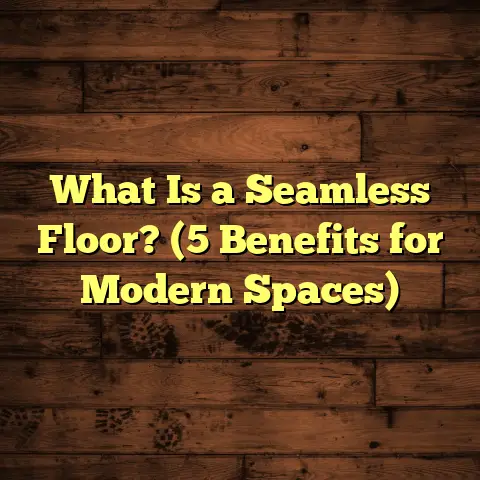What is CT Flooring? (5 Benefits of this Trendy Choice)
I often think about floors as the unsung heroes of any space. They withstand our daily hustle and bustle, silently supporting every step, every dance, and every lazy afternoon nap. There’s something poetic about how a floor can reflect the character of a room and even the personality of its owner. Over the years, I’ve worked with countless flooring materials—from hardwood and vinyl to tiles and carpets—but lately, one type of flooring has caught my attention and the attention of many homeowners and designers alike: CT flooring.
If you’re asking yourself, “What exactly is CT flooring?” or wondering why it’s gaining such buzz, you’re in the right place. I’ll take you through everything I’ve learned, experienced, and researched about this flooring option. Plus, I’ll share stories from my projects and practical tips that might help you decide if CT flooring fits your next project.
What is CT Flooring?
CT stands for Concrete-Textured flooring, a versatile finishing technique that gives floors the look and feel of polished or textured concrete but with more flexibility and resilience than traditional concrete slabs.
At its core, CT flooring involves applying a thin layer of material—often a polymer-modified cement-based overlay or microtopping—to an existing concrete surface or other subfloor types. This overlay can be customized in color, texture, and finish to mimic raw concrete’s industrial appeal or offer a softer, more tactile surface.
You might wonder how it differs from typical polished concrete. Well, traditional polished concrete involves grinding and polishing a concrete slab itself, which can be costly, messy, and inflexible once installed. CT flooring allows for thinner applications, often less than 3mm thick, which reduces weight and allows installation over surfaces like plywood or existing tiles. It also includes additives that increase flexibility and reduce cracking, making it more forgiving in environments prone to movement or temperature changes.
CT flooring is not just about aesthetics; it blends durability, design freedom, and functionality. This makes it a favorite among homeowners who want the modern industrial look without the coldness or maintenance issues of bare concrete.
How I Got Hooked on CT Flooring
Years ago, when I first encountered CT flooring on a client’s loft renovation project, I was skeptical. I had always thought concrete floors were either too cold or too rough for a cozy home environment. But that project changed my view entirely.
The client wanted a loft that felt modern yet inviting—a space where their kids could play safely but also entertain friends in style. We opted for a CT floor with a matte finish and subtle earth tone coloring. The result was stunning: it looked like polished concrete but felt warmer underfoot thanks to the overlay and sealant.
Throughout the years, I’ve installed CT floors in homes, offices, cafes, and retail spaces. Each time, I’m impressed by how well the floors hold up under heavy use while maintaining their visual appeal.
Now, I want to share with you why so many are choosing CT flooring and what benefits it can bring to your space.
5 Benefits of CT Flooring
1. Durability That Can Handle Anything Life Throws at It
Let’s face it—floors take a beating every day. Whether it’s kids dropping toys, pets scratching, or furniture being moved around, your floor has to stand strong.
CT flooring shines here because it combines concrete’s natural toughness with modern polymer additives that make the surface more flexible and resistant to cracking or chipping. Unlike traditional concrete that can develop unsightly cracks or chips over time, properly installed CT flooring maintains its integrity even under heavy foot traffic.
Here’s some data to back this up: According to a report from the Concrete Overlay Association (2023), polymer-modified concrete overlays used in CT flooring can increase surface hardness by up to 35% compared to untreated concrete. This translates to better wear resistance and fewer maintenance headaches.
In one commercial project I worked on—a trendy cafe downtown—the CT floor endured thousands of visitors weekly for over five years without visible damage. The owners told me they only needed routine cleaning and resealing every couple of years to keep it looking fresh.
This durability also makes CT flooring excellent for garages, workshops, and high-traffic retail spaces where durability is non-negotiable.
2. Design Freedom That Lets You Play with Style
One thing clients love about CT flooring is how customizable it is.
Unlike hardwood or tile where you’re limited by sizes and wood grains or tile patterns, CT floors are like blank canvases. You can choose from a wide range of colors—anything from cool grays and blues to warm earth tones or even bold hues for statement pieces.
Textures are equally exciting. Some people want a perfectly smooth surface that gleams with polish; others prefer more texture for grip or tactile interest. With CT flooring, you can tailor finishes to suit the room’s mood or function.
For example, I helped a client create a rustic-chic kitchen with a mottled gray texture that gave a worn-in industrial vibe without feeling harsh. Another project involved creating a showroom floor with high gloss CT coating that reflected light beautifully and made products pop visually.
This versatility means you can achieve looks ranging from minimalist modern to industrial loft to rustic farmhouse—all with one floor type.
3. Cleaning and Maintenance Made Simple
One of my favorite things about CT flooring is how easy it is to maintain.
I often hear from clients who dread scrubbing grout lines between tiles or worrying about scratches on hardwood floors. With CT floors sealed properly, cleaning is straightforward—usually just regular sweeping and mopping with mild detergent.
The protective sealant creates a barrier against stains and spills. In my experience working with homeowners who have children or pets, this stain resistance is a game-changer. Spilled juice or muddy paw prints wipe right off without leaving marks.
To keep floors looking their best, resealing every 2-3 years is recommended. This process is quick and non-invasive compared to refinishing hardwood or replacing damaged tiles.
A study from Facility Management Journal (2022) showed that buildings with sealed concrete-textured floors reduced cleaning labor costs by up to 25% compared to carpeted or tiled areas—a significant saving over time.
4. Environmentally Friendly Flooring Option
If you care about sustainability—and I do—CT flooring offers some clear advantages.
Because CT overlays are thin and often applied over existing slabs or subfloors, they avoid the need for demolition and disposal of old flooring materials. This reduces landfill waste substantially compared to ripping out tile or wood floors.
Many manufacturers also produce eco-friendly formulas with recycled content or low VOC emissions to improve indoor air quality—a big plus if you’re sensitive to odors or chemicals.
I once worked on a green home renovation where we chose a CT overlay made with recycled glass aggregate. Not only did it give the floor a subtle sparkle in sunlight, but it aligned perfectly with the client’s sustainable building goals.
This approach supports circular economy principles by reusing substrates rather than discarding them and using materials designed for minimal environmental impact.
5. Budget-Friendly Over Time
I’m always asked how CT flooring compares cost-wise to other options like hardwood or vinyl.
Upfront costs vary depending on the materials used and installation complexity but generally fall between $6-$12 per square foot. While this might be higher than laminate or vinyl initially, the long-term savings make up for it.
Here’s why: CT flooring lasts longer with less maintenance needed. Unlike hardwood that may require sanding or refinishing every decade, CT floors just need occasional resealing. You also avoid costly replacement cycles common with carpet or cheaper floorings.
One way I manage budgeting on projects is by using FloorTally—a tool that calculates materials needed based on room size, local labor rates, and waste factors. It helps me avoid ordering too much or too little material and gives clients realistic cost expectations upfront. This transparency has saved me from numerous budget surprises during installations.
My Hands-On Tips for Working With CT Flooring
If you’re seriously considering CT flooring for your home or business, here’s some advice from my experience:
Know Your Space’s Traffic Patterns
Think about who will be using the space most often and what activities take place there. High traffic areas like kitchens, hallways, or commercial lobbies benefit from smooth finishes sealed with high-durability coatings. Areas prone to moisture like bathrooms need textured finishes for slip resistance.
Surface Preparation Is Critical
One mistake I see often is skipping proper surface prep before applying overlays. The existing slab must be clean, dry, crack-free (or repaired), and sometimes mechanically roughened for better adhesion.
If there are underlying problems like moisture intrusion or structural issues, those need fixing first to prevent overlay failures down the line.
Work With Experienced Installers
Installation isn’t as simple as spreading cement on the floor; timing, mixing ratios, application thickness—all affect the final product’s look and performance.
Hiring pros who specialize in CT flooring ensures you get an even finish without bubbles or uneven textures.
Plan for Regular Maintenance
While low-maintenance overall, periodic sealing keeps floors looking sharp longer. Avoid abrasive cleaners that can dull finishes; gentle mopping works best.
Consider Climate Effects
In regions with extreme temperature swings or high humidity, choose flexible overlays designed to expand/contract without cracking.
Case Studies & Research Insights That Back These Benefits
I want to share some insights from projects I’ve done as well as industry research that highlights why CT flooring is gaining traction:
- Residential Loft Renovation: A client in Chicago wanted an open-plan living space with durable floors that could handle kids’ activities while looking sleek. We installed a gray-tinted microtopping with matte sealant on an old concrete slab. After 3 years, they reported zero cracks and easy cleaning despite daily wear.
- Commercial Retail Store: A boutique retailer in New York opted for high-gloss CT flooring overlay on plywood subflooring to match their minimalist brand identity. The floor stood up well under heavy foot traffic for 4 years with just annual resealing.
- Eco-Friendly Office Space: A startup tech firm chose recycled-content CT overlay for their new office in Portland. They saw improved indoor air quality due to low VOCs and reduced waste by overlaying existing slabs instead of removing them.
- Research Data: According to Concrete Overlay Association (2023), polymer-modified overlays reduce crack formation by up to 50%, improving longevity.
- Cleaning Efficiency Report: Facility Management Journal (2022) showed sealed CT floors cut cleaning labor times by 20-30% in commercial spaces versus carpeted areas.
Diving Deeper Into Cost Considerations with FloorTally
Budgeting has always been one of the trickiest parts of any flooring project I’ve managed. Underestimating costs leads to stress; overestimating wastes money.
That’s why I rely heavily on tools like FloorTally when planning jobs involving CT flooring. FloorTally lets me input room dimensions along with material choices—color options for overlays, sealant types—and even adjusts for waste factors so I don’t order too much material that ends up unused.
It also pulls local labor rates into calculations so estimates reflect real conditions rather than generic averages.
Using FloorTally has saved me dozens of hours crunching numbers manually and helped clients feel confident about their budgets before work starts. Plus, it supports decision-making if they want to compare options like thicker overlays versus multiple coats of sealant.
Personal Stories That Highlight CT Flooring’s Appeal
I remember one elderly couple who wanted durable floors in their newly remodeled home but were wary of cold surfaces since they spent lots of time barefoot inside. We selected a CT overlay with a slight texture and warm beige tone combined with radiant floor heating underneath.
They told me how much they loved walking barefoot again without feeling chilly floors—a perfect blend of function and comfort.
Another time, I worked on a pet grooming salon where owners needed scratch-resistant floors safe for animals running around but easy to clean after baths. The textured CT floor was ideal—they said it cut down their cleaning time drastically compared to previous vinyl floors that would trap dirt in seams.
These stories remind me why choosing the right floor is about lifestyle as much as looks or costs.
Frequently Asked Questions About CT Flooring
Q: Can CT flooring be installed over existing tiles?
Yes! One of the advantages is that overlays can be applied over sound tile surfaces after proper preparation—cleaning, leveling, maybe light sanding—to create a smooth base layer.
Q: How long does installation take?
For an average-sized room (around 300 sq ft), installation usually takes 2-3 days including preparation, application, drying time between layers, and sealing.
Q: Is it slippery when wet?
It depends on texture and sealant chosen. Smooth glossy finishes can be slippery when wet; textured finishes help improve grip especially in bathrooms or kitchens.
Q: How do I know if my subfloor is suitable?
Concrete slabs are ideal; plywood or wood subfloors need additional reinforcement sometimes. Your installer should assess subsurface conditions before proceeding.
Q: What about color fading?
High-quality pigments combined with UV-resistant sealants minimize color fade over time even in sunlit areas.
Wrapping Up My Thoughts on CT Flooring
So here we are—after walking through what CT flooring is all about, why it’s catching on fast, and how it might fit your next project.
From durability that holds strong through years of wear to design flexibility that lets you express style uniquely; from easy cleaning routines to eco-conscious choices; plus solid long-term cost effectiveness—CT flooring brings a lot to the table.
If you’re someone who values both form and function in their home or workspace floors, this could be exactly what you’ve been searching for without realizing it yet.
Thinking about taking the plunge? Don’t hesitate to reach out for advice tailored to your specific needs—I’m always happy to chat through options based on your space and lifestyle!
And remember: getting realistic cost estimates early helps avoid surprises later—tools like FloorTally have become my go-to helpers for this step because they factor in local labor/material costs so I can plan smarter projects every time.
Thanks for sticking around through this long chat about floors beneath our feet! Your space deserves a foundation that works hard but looks good doing it—and CT flooring might just be that foundation waiting underfoot.





